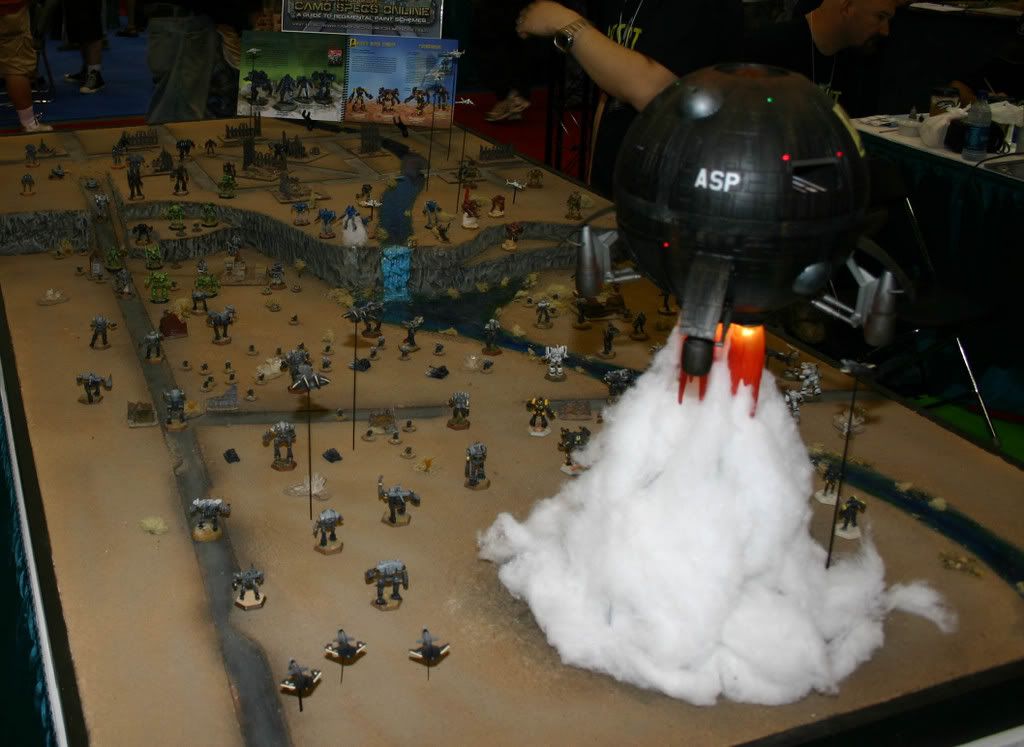More images of the 2007 Camospecs diorama on my p-bucket albums. Blame Steven Satak for the incredible Union dropship model.
28 November 2009
Engine 371
No robots today - This is a short film - Engine 371 by Kevin Langdale about (stay with me here) the Canadian Transcontinental Railroad. It's also a model railroader's dream come to life, and illustratse how model railroad enthusiasts see their creations.
Battletech players Gamers are the same way about their miniatures and the game worlds they come from. The imagination lets it come alive and surpass the borders of the table top.
More images of the 2007 Camospecs diorama on my p-bucket albums. Blame Steven Satak for the incredible Union dropship model.
More images of the 2007 Camospecs diorama on my p-bucket albums. Blame Steven Satak for the incredible Union dropship model.
05 November 2009
A few hours in the library
As the saying goes among those engaged in research, "A few hours in the library can save you a few months in the laboratory". (The order is sometimes switched to turn this into a joke, "A few months in the laboratory can save you a few hours in the library".). In my case, a few minutes with Google may save me a few months of banging on a spreadsheet program or R program trying to puzzle out some difficult mathematics. Earlier today I made an interesting find:
This is a recent article that describes a mathematical model closely related to something I'm trying to work out for Battletech. The probability distribution that describes how long a Battlemech will survive during play is very complex, which is no surprise, but then I discovered I was still underestimating the problem. The article above describes a type of situation similar to what occurs in Battletech, and demonstrates a nice matrix based approach to formulating the problem.
The "phase" in Phase-Type distribution refers to the particular state of the system. In Battletech terms, the starting phase would be an undamaged mech, the end phase (absorbing state) would be the head, center torso, or engine destruction, and the phases in between would represent various states of destruction in between. The diagram below (borrowed from the PhD Thesis: Aggregate Matrix-analytic Techniques and their Applications of Alma Riska, PhD), shows an example. Here the undamaged starting "phase 0" would be state "0,0" on the left, phase 1 would be any single (non-fatal) section destroyed) such as either arm destroyed (not both), which might correspond to the "0,1" and "0,2" states. Phase 2 would be any legal combination of two destroyed locations, 3 for phase 3, and so on.
The arrows connecting the states represent the probability of moving from one state to another The whole thing can be written as a matrix giving the probability of moving from one state to another at a given time. Battletech has at least 150 states, and a complex interconnections. It's complicated, but now I know it can be done, and I have a new line of study to help me figure out how to do it.
That problem is on the back burner for a while though. I am presently working on something simpler that might have more immediate and practical application. Work and home have been very busy, so progress is slow. Soon, I hope.
[subscription access required for the article, otherwise you just see the abstract.]
This is a recent article that describes a mathematical model closely related to something I'm trying to work out for Battletech. The probability distribution that describes how long a Battlemech will survive during play is very complex, which is no surprise, but then I discovered I was still underestimating the problem. The article above describes a type of situation similar to what occurs in Battletech, and demonstrates a nice matrix based approach to formulating the problem.
The "phase" in Phase-Type distribution refers to the particular state of the system. In Battletech terms, the starting phase would be an undamaged mech, the end phase (absorbing state) would be the head, center torso, or engine destruction, and the phases in between would represent various states of destruction in between. The diagram below (borrowed from the PhD Thesis: Aggregate Matrix-analytic Techniques and their Applications of Alma Riska, PhD), shows an example. Here the undamaged starting "phase 0" would be state "0,0" on the left, phase 1 would be any single (non-fatal) section destroyed) such as either arm destroyed (not both), which might correspond to the "0,1" and "0,2" states. Phase 2 would be any legal combination of two destroyed locations, 3 for phase 3, and so on.
The arrows connecting the states represent the probability of moving from one state to another The whole thing can be written as a matrix giving the probability of moving from one state to another at a given time. Battletech has at least 150 states, and a complex interconnections. It's complicated, but now I know it can be done, and I have a new line of study to help me figure out how to do it.
That problem is on the back burner for a while though. I am presently working on something simpler that might have more immediate and practical application. Work and home have been very busy, so progress is slow. Soon, I hope.
Subscribe to:
Posts (Atom)



